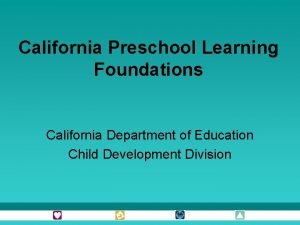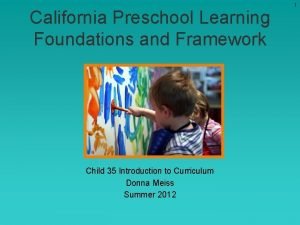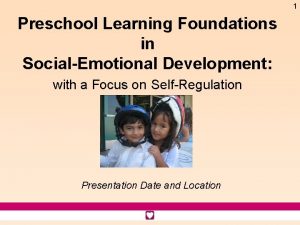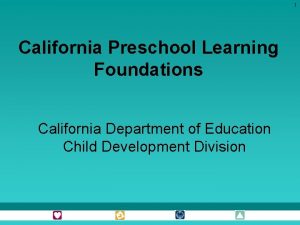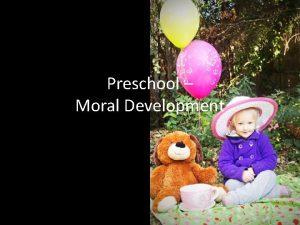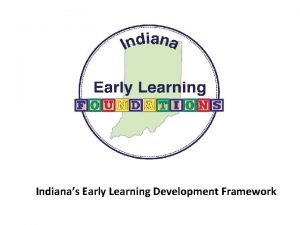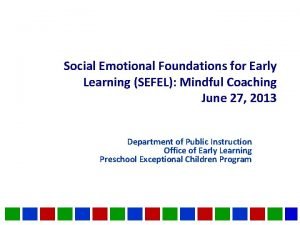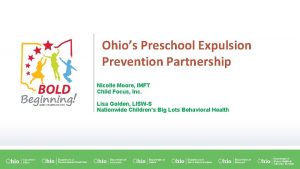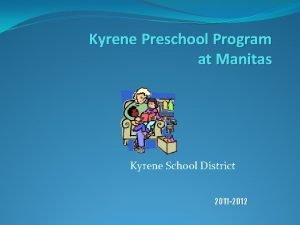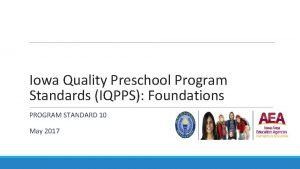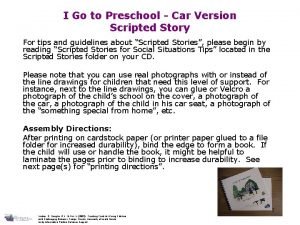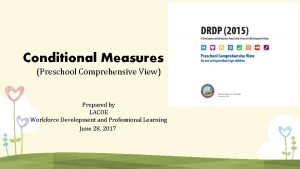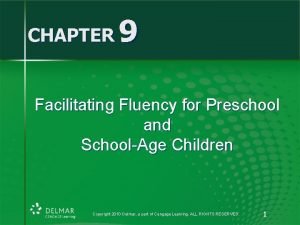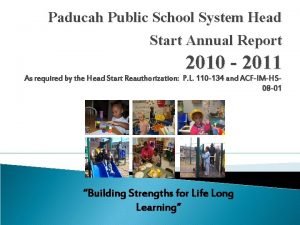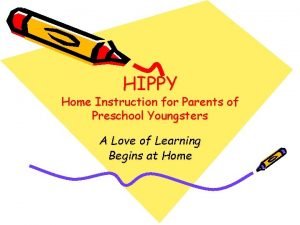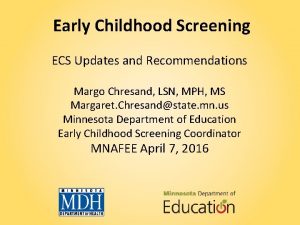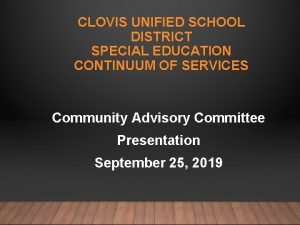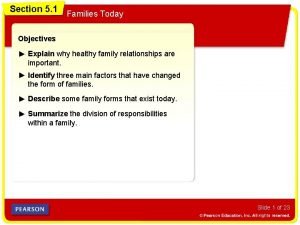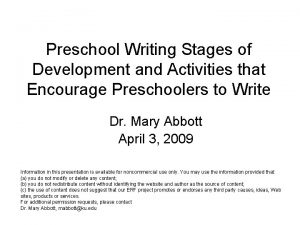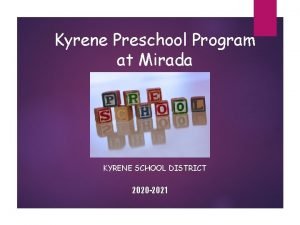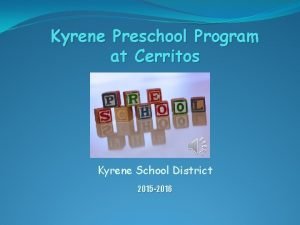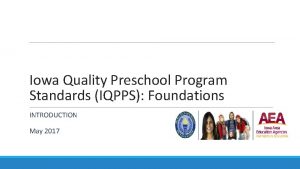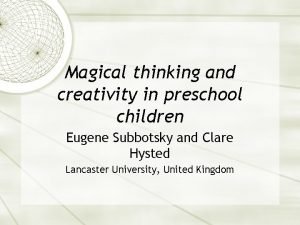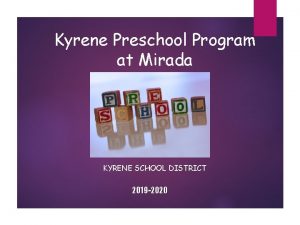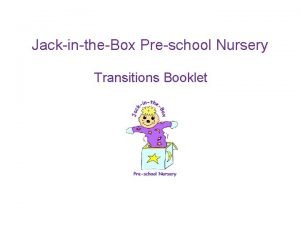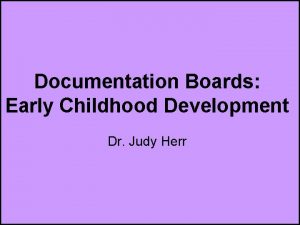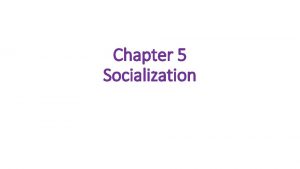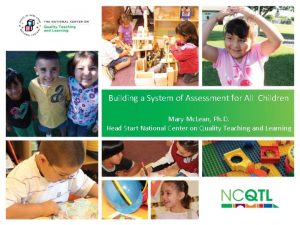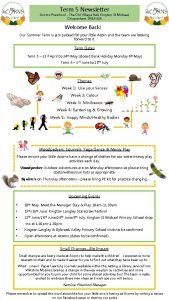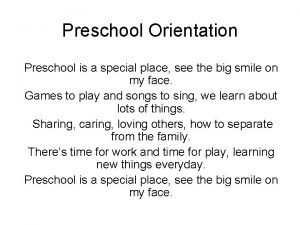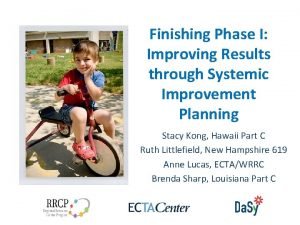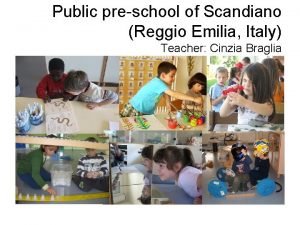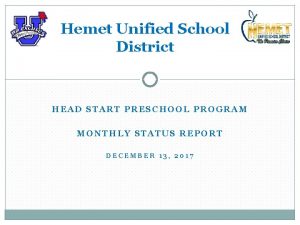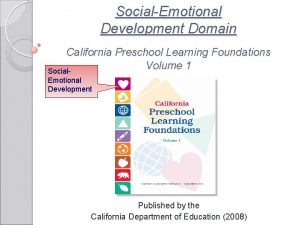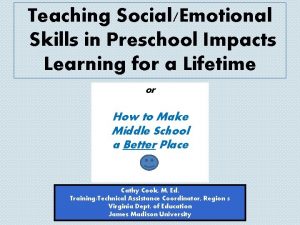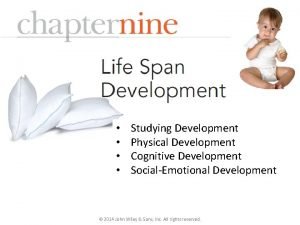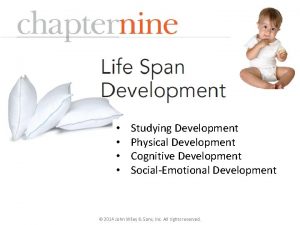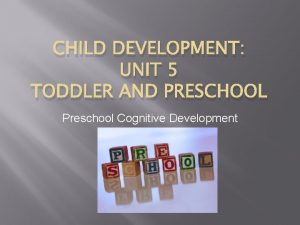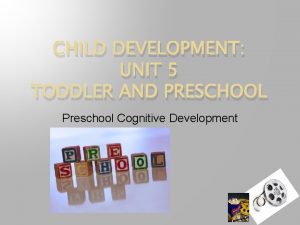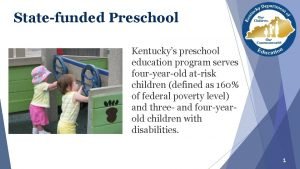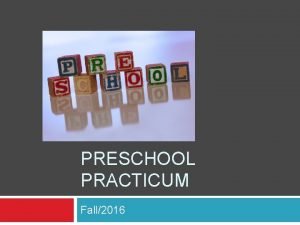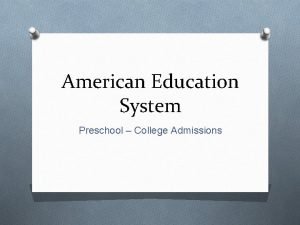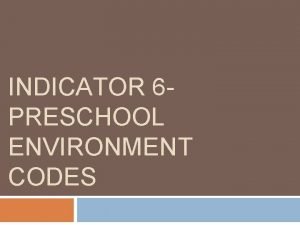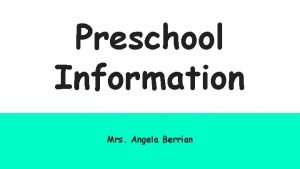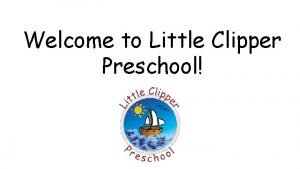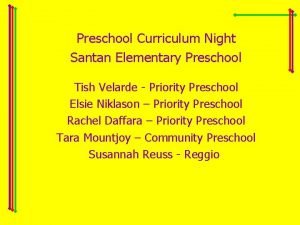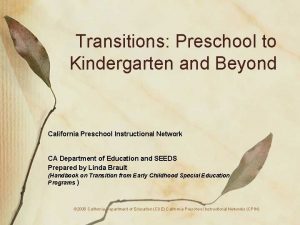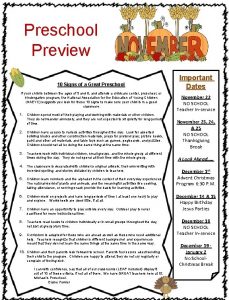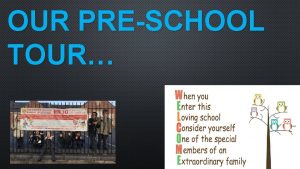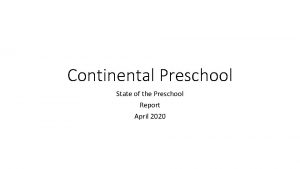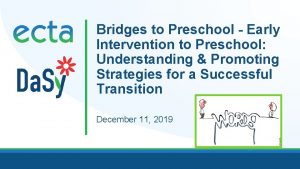1 Preschool Learning Foundations in SocialEmotional Development with























































- Slides: 55

1 Preschool Learning Foundations in Social-Emotional Development: with a Focus on Self-Regulation Presentation Date and Location

2 Welcome! Insert Names of Presenters (Regional Leads)

3 Norms • Begin on time and end on time • Turn cell phones to vibrate • Help the group stay on task • Listen to thoughts and ideas of others • Contribute your thoughts and ideas

4 Session Outcomes • Become familiar with the preschool learning foundations in social-emotional development with a focus on the self-regulation substrand. • Become familiar with current research on socialemotional development. • Connect the foundations to effective strategies that build positive relationships and support the development of self-regulation skills.

5 California Preschool Learning Foundations, Volume 1 Social-Emotional Development Language and Literacy English-Language Development Mathematics Visual and Performing Arts Physical Development Health History-Social Science

Preschool Learning Foundations Central Assumption “School readiness consists of socialemotional competencies as well as cognitive and motivational ones. ” Source: California Preschool Learning Foundations, Volume I, CDE Press, 2008, pg 1. 6

7 Foundations in Social. Emotional Development Identify important social and emotional competencies for school readiness.

8 Learning and Growing Activity • Individually record your thoughts. • In table groups, discuss the social and emotional competencies identified. • On chart paper draw a child and write the competencies (behaviors and skills) identified by your group.

Foundations in Social-Emotional Development Chapter • • • Introduction (pp. 1 -5) The Foundations (pp. 6 -20) Bibliographic notes (pp. 21 -34) Glossary (p. 35) References and Source Material (pp. 36 -45) 9

10 Strand Map of the Foundations Social-Emotional Development Self Domain Substrand Age Foundation description Examples Handout 1

11 Foundations in Social-Emotional Development Self Social Interaction Relationships Self-Awareness Interaction with Familiar Adults Attachment to Parents Self-Regulation Interaction with Peers Close Relationships with Teachers and Caregivers Social and Emotional Understanding Group Participation Friendships Empathy and Caring Cooperation and Responsibility Initiative in Learning Source: California Preschool Learning Foundations, CDE Press, 2008.

Foundations in Social-Emotional Development Activity • Find the envelope on the table labeled Social. Emotional Development. • Divide the foundations among the participants at the table and read them aloud. • Discuss how the foundations are related to the competencies placed on the chart. • Place the foundations on the chart. 12

13 Assumption “Young children have access to the appropriate kinds of social interactions, experiences, and environments that normally support healthy development. ” Source: California Preschool Learning Foundations, Volume I, CDE Press, 2008, p. 1.

14 Assumption “The purpose of these foundations is to describe typical development rather than to articulate aspirational expectations for children’s behavior under the best possible conditions or for the behaviors to be instilled in children. ” Source: California Preschool Learning Foundations, Volume I, CDE Press, 2008, pg 2.

15 Assumption “These foundations, especially the behavioral examples for each foundation, are not meant to be assessment items; rather, they are meant to be guidelines and teaching tools. ” Source: California Preschool Learning Foundations, Volume I, CDE Press, 2008, pg 2.

Cognitive, Social, and Emotional Development are Deeply Interdependent in the Early Years Emotional health and social competence are a strong foundation for emerging cognitive abilities. Ross A. Thompson, CPIN Research Institute, 2008. 16

17 The Importance of the Early Years • This developing brain architecture is rooted in the context of experience and is the foundation for cognitive, social and emotional development. • Brain development is dependent on experience. • Brain development is rapid in the early years and continuous throughout adulthood. Neurons to Neighborhoods

18 Brain growth in the early years

19 Early brain development Amygdala Hippocampus Prefrontal Cortex

20 Stress and Brain Development Positive stress—short lived, typical daily challenges, builds coping skills Tolerable stress—short term intense stress, buffered by supportive adults Toxic stress—prolonged intense stress in the absence of protection by supportive adults, disrupts brain structure, increased risk of physical and mental illness Ross A. Thompson, CPIN Research Institute, 2008

21 Stressors and Buffers • Use the activity sheet and write down one stressor that you may experience in your life. • On the activity sheet write down strategies and resources (buffers) that you have to help you cope with this stressor. • What buffers do children in your group use to help themselves cope with stress? How might you enhance the buffers available to children in your classroom? Handout 2

22 Plasticity • Brain architecture has great plasticity and continues to change throughout life. • Emotional competencies that may not have been developed naturally can be taught through purposeful teaching and strategic planning.

23 Quality Relationships

24 Getting to Know You Handout 3

25 Click for next slide

26 Click for next slide

27 It Takes a Lot of Love

28 Click for next slide

29 Click for next slide

30 Making Deposits Handout 4

31 Click for next slide

32 Click for next slide

For More Information about Building Relationships 33 Handout 5: Building Positive Relationships with Young Children is a summary and extension of what we have discussed here today. This handout comes from the Center for Evidence-Based Practices for Early Learning. Handout 5

The Self-Regulation Strand of the Social-Emotional Domain The growth of selfregulation is a cornerstone of early childhood development that cuts across all domains of behavior. Neurons to Neighborhoods 34

Self-Regulation Includes the Skills to: • • Cooperate Focus attention Manage transitions Follow routines Manage strong emotions Share things and space Wait and take turns Adapted from the California Preschool Learning Foundations, Volume 1, p. 7 35

A Few Ways Adults Can Help Children Learn to Self-Regulate • Tell children what to do, not what not to do. • Help children use words to regulate their actions and thinking. • Model self-control and consideration for others. • Balance active and quiet periods, individual and group activities. • Break up complex behaviors into smaller parts (see next slide). Ross A. Thompson, CPIN Research Institute, 2008 36

37 Hand Washing Routine 1. 2. 3. 4. 5. 6. 7. 8. Go to the sink. Turn on the water. Put soap on your hands. Lather hands for 20 seconds. Rinse hands under water. Dry hands with paper towel. Turn off faucet with paper towel. Put paper towel in trash.

Teacher Strategies to Support Social-Emotional Focus Handout 6 38

Strategies for Preventing Challenging Behaviors • Effective Classroom Environments • Predictable Daily Schedule • Rules, Rituals, and Routines “Preventing Challenging Behavior in Young Children: Effective Practices” by P. Alter & M. Conroy, Center for Evidence-Based Practice: Young Children with Challenging Behavior 39

Effective Classroom Environments 1. Physical arrangement • • • Adults can visually monitor children. Limit the number of children in centers. Materials are organized wisely on shelves. Toys are accessible, appropriate to age level, plentiful. Lighting, noise level and temperature are monitored. “Preventing Challenging Behavior in Young Children: Effective Practices” by P. Alter & M. Conroy, Center for Evidence-Based Practice: Young Children with Challenging Behavior 40

Effective Classroom Environments 2. Interpersonal climate • Activities are engaging and developmentally appropriate. • Teachers provide assistance as children need help. • Positive attention and feedback are given to appropriate behaviors. “Preventing Challenging Behavior in Young Children: Effective Practices” by P. Alter & M. Conroy, Center for Evidence-Based Practice: Young Children with Challenging Behavior 41

42 Predictable Daily Schedule • Use picture schedules that provide concrete cues of activities and routines. • Rotate small and large group activities. • Vary active and quiet activities. • Put more difficult activity at a time when children are most alert and attentive. “Preventing Challenging Behavior in Young Children: Effective Practices” by P. Alter & M. Conroy, Center for Evidence-Based Practice: Young Children with Challenging Behavior

43 Predictable Daily Schedule • Complex activities are discussed and broken down by what happens first, next and so forth, so children know what to expect. • Children are given choices within the schedule (center time activities, outdoor areas). “Preventing Challenging Behavior in Young Children: Effective Practices” by P. Alter & M. Conroy, Center for Evidence-Based Practice: Young Children with Challenging Behavior

44 Rules, Rituals, and Routines • Rules provide a structure in which to teach preschoolers which behaviors are appropriate and inappropriate. • Rituals and routines such as songs, rhymes, games, and kinesthetic movement can foster community-building and can remind children of appropriate behaviors. “Preventing Challenging Behavior in Young Children: Effective Practices” by P. Alter & M. Conroy, Center for Evidence-Based Practice: Young Children with Challenging Behavior

45 Additional Resources • Handout 7: Guidelines • Handout 8: Strategies for Responding • Handout 9: Policy Brief: Children with special needs • Handout 10 and 11: Quick reminders Handouts 7, 8, 9, 10, 11

46 DRDP-R and Foundations

47 From Theory to Practice

48 From Theory to Practice • • Bringing your handouts with you, have your group begin at one of the tables. Take 10 minutes to read the problem and chart suggested strategies. After 10 minutes, move to the next table. Read the problem and strategies developed by the previous group, and additional strategies. You have six minutes for this turn. At the signal, move again to the next table and repeat the process.

49 Q&A

50 CDE Web Site • At the Web address, the underlined Preschool Learning Foundations link takes you to the publication. There you will find easy access to the chapters and sections within the 192 page publication. • The Appendix, on pages 173 -192, provides a summary list of the foundations. • Frequently Asked Questions (FAQ) are posted on the Web site. Questions can be sent to psfoundations@cde. ca. gov.

51 The entire document is online at the California Department of Education Web site. http: //www. cde. ca. gov/sp/cd/re/psfoundations. asp

To Purchase Preschool Learning Foundations Book • The California Preschool Learning Foundations, Volume 1, publication is available for purchase from the CDE Press for $19. 95 plus shipping and handling. • Ordering information can be found at the CDE Web site www. cde. ca. gov/re/pn/rc or by calling 1 - 800 -995 -4099. 52

53 To Purchase PEL Guide • Preschool English Learners: Principles and Practices to Promote Language, Literacy and Learning publication is available for purchase from the CDE Press for $15. 95. • Ordering information can be found at the CDE Web site www. cde. ca. gov/re/pn/rc or by calling 1 -800 -995 -4099. • Appendix A has been translated into Chinese, Hmong, Korean, Spanish, Tagalog, and Vietnamese, and is available on the CDE Web site. NOW in Spanish!

Please Complete an Evaluation Form Fill-in the bubbles completely. Use pencil, black, or blue ink. 54

55 Thank you for coming! • Insert Local Information Here
 California preschool foundations
California preschool foundations Preschool learning foundations volume 1
Preschool learning foundations volume 1 Preschool learning foundations volume 3
Preschool learning foundations volume 3 Preschool learning foundations social emotional
Preschool learning foundations social emotional California preschool learning foundations
California preschool learning foundations Preschool learning foundations math
Preschool learning foundations math Preschool learning foundations
Preschool learning foundations Preschool learning foundations math
Preschool learning foundations math California preschool curriculum framework volume 1
California preschool curriculum framework volume 1 Preschool moral development
Preschool moral development Indiana learning foundations
Indiana learning foundations Sefel training
Sefel training Foundations of curriculum
Foundations of curriculum Which css property configures the font typeface?
Which css property configures the font typeface? Cuadro comparativo e-learning m-learning b-learning
Cuadro comparativo e-learning m-learning b-learning Drdp modified essential view
Drdp modified essential view Preschool in ukraine
Preschool in ukraine Expulsions
Expulsions Kyrene school schedule
Kyrene school schedule Iqpps standards
Iqpps standards Scripted stories for preschool
Scripted stories for preschool Clouds preschool etiwanda
Clouds preschool etiwanda Drdp (2015 fundamental view)
Drdp (2015 fundamental view) Preschool fluency activities
Preschool fluency activities Bus stop preschool
Bus stop preschool Saguaro infant care and preschool
Saguaro infant care and preschool Paducah head start preschool
Paducah head start preschool Kpi for preschool teachers
Kpi for preschool teachers Hippy home instruction for parents of preschool youngsters
Hippy home instruction for parents of preschool youngsters Early childhood screening rochester mn
Early childhood screening rochester mn Contents training clovis
Contents training clovis Today more than half of all mothers with preschool
Today more than half of all mothers with preschool Phases of writing development
Phases of writing development Panorama heights preschool
Panorama heights preschool Hollingworth preschool
Hollingworth preschool Kyrene school district preschool
Kyrene school district preschool Kyrene school district preschool
Kyrene school district preschool Iqpps
Iqpps Preschool room arrangement
Preschool room arrangement Modbury south preschool
Modbury south preschool Preschool prefix
Preschool prefix Magical thinking preschool
Magical thinking preschool Kyrene mirada
Kyrene mirada Jack in the box
Jack in the box Documentation boards for preschool
Documentation boards for preschool Egalia preschool sweden
Egalia preschool sweden Drdp preschool measures at a glance
Drdp preschool measures at a glance Preschool westlake
Preschool westlake Virginia preschool initiative income guidelines 2020
Virginia preschool initiative income guidelines 2020 June preschool newsletter
June preschool newsletter A special place preschool
A special place preschool Preschool infrastructure
Preschool infrastructure Christ lutheran preschool avon lake
Christ lutheran preschool avon lake Reggio emilia italy preschool
Reggio emilia italy preschool Preschool hemet
Preschool hemet Etiwanda clouds
Etiwanda clouds
